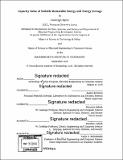| dc.contributor.advisor | Audun Botterud. | en_US |
| dc.contributor.author | Byers, Conleigh. | en_US |
| dc.contributor.other | Massachusetts Institute of Technology. Institute for Data, Systems, and Society. | en_US |
| dc.contributor.other | Technology and Policy Program. | en_US |
| dc.contributor.other | Massachusetts Institute of Technology. Department of Electrical Engineering and Computer Science. | en_US |
| dc.date.accessioned | 2019-11-12T17:42:40Z | |
| dc.date.available | 2019-11-12T17:42:40Z | |
| dc.date.copyright | 2018 | en_US |
| dc.date.issued | 2018 | en_US |
| dc.description | Thesis: S.M. in Technology and Policy, Massachusetts Institute of Technology, School of Engineering, Institute for Data, Systems, and Society, Technology and Policy Program, 2018 | en_US |
| dc.description | Thesis: S.M., Massachusetts Institute of Technology, Department of Electrical Engineering and Computer Science, 2018 | en_US |
| dc.description | Cataloged from PDF version of thesis. | en_US |
| dc.description | Includes bibliographical references (pages 71-74). | en_US |
| dc.description.abstract | Variable renewable energy (VRE) resources account for approximately half of new capacity additions in independent system operator (ISO) markets in the United States in the last five years. When designing and implementing capacity markets, system operators need to estimate future system capacity needs and often set maximum limits on the capacity different technologies can trade in the capacity market based on the expected contribution of each technology, including generation and demand, to system adequacy. Current capacity market designs often consider each resource independently, irrespective of the system's portfolio of resources, potentially overvaluing or undervaluing the capacity contribution of VRE and energy storage in the grid. We explore a method for calculating the standalone and integrated capacity value of an added VRE resource with existing energy storage resources. The difference between the integrated and standalone value is the portfolio effect, the additional capacity value gained by the synergy of VRE and the existing fleet. We also demonstrate a new method for translating a normalized expected unserved energy (EUE) target into required additional firm capacity and then into the standalone and integrated capacity values of an added VRE resource. | en_US |
| dc.description.statementofresponsibility | by Conleigh Byers. | en_US |
| dc.format.extent | 74 pages | en_US |
| dc.language.iso | eng | en_US |
| dc.publisher | Massachusetts Institute of Technology | en_US |
| dc.rights | MIT theses are protected by copyright. They may be viewed, downloaded, or printed from this source but further reproduction or distribution in any format is prohibited without written permission. | en_US |
| dc.rights.uri | http://dspace.mit.edu/handle/1721.1/7582 | en_US |
| dc.subject | Institute for Data, Systems, and Society. | en_US |
| dc.subject | Technology and Policy Program. | en_US |
| dc.subject | Electrical Engineering and Computer Science. | en_US |
| dc.title | Capacity value of variable renewable energy and energy storage | en_US |
| dc.title.alternative | Capacity value of VRE and energy storage | en_US |
| dc.type | Thesis | en_US |
| dc.description.degree | S.M. in Technology and Policy | en_US |
| dc.description.degree | S.M. | en_US |
| dc.contributor.department | Massachusetts Institute of Technology. Institute for Data, Systems, and Society | en_US |
| dc.contributor.department | Massachusetts Institute of Technology. Department of Electrical Engineering and Computer Science | en_US |
| dc.contributor.department | Massachusetts Institute of Technology. Engineering Systems Division | |
| dc.contributor.department | Technology and Policy Program | |
| dc.identifier.oclc | 1126791488 | en_US |
| dc.description.collection | S.M.inTechnologyandPolicy Massachusetts Institute of Technology, School of Engineering, Institute for Data, Systems, and Society, Technology and Policy Program | en_US |
| dc.description.collection | S.M. Massachusetts Institute of Technology, Department of Electrical Engineering and Computer Science | en_US |
| dspace.imported | 2019-11-19T22:21:11Z | en_US |
